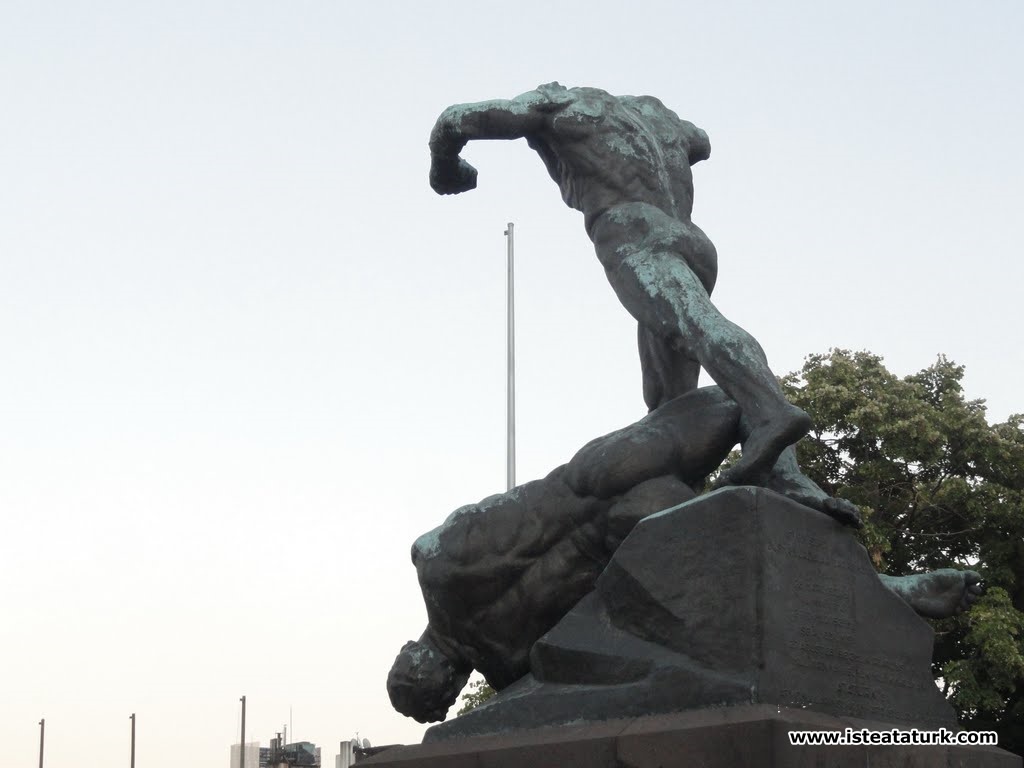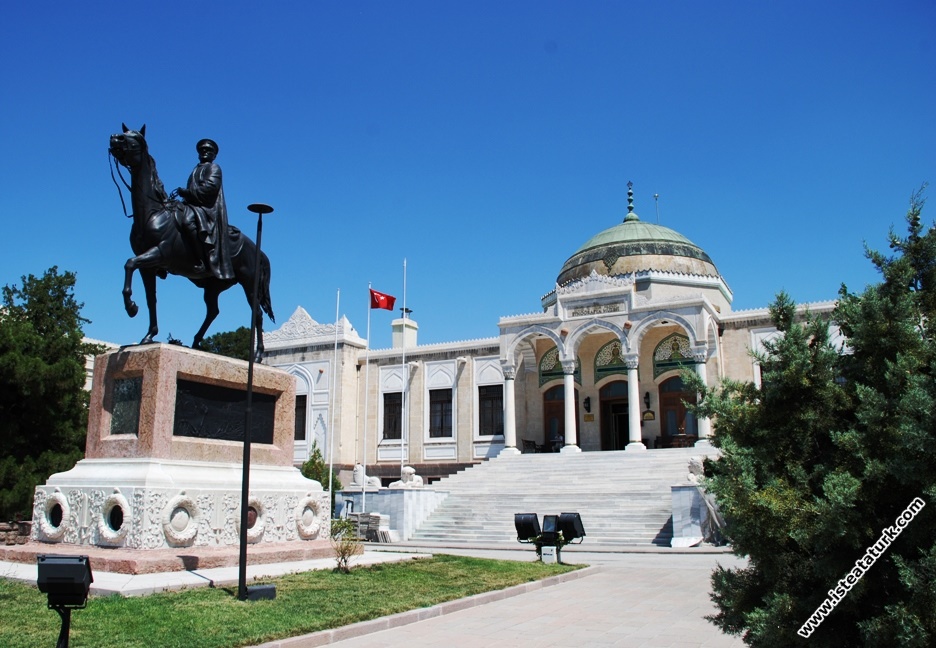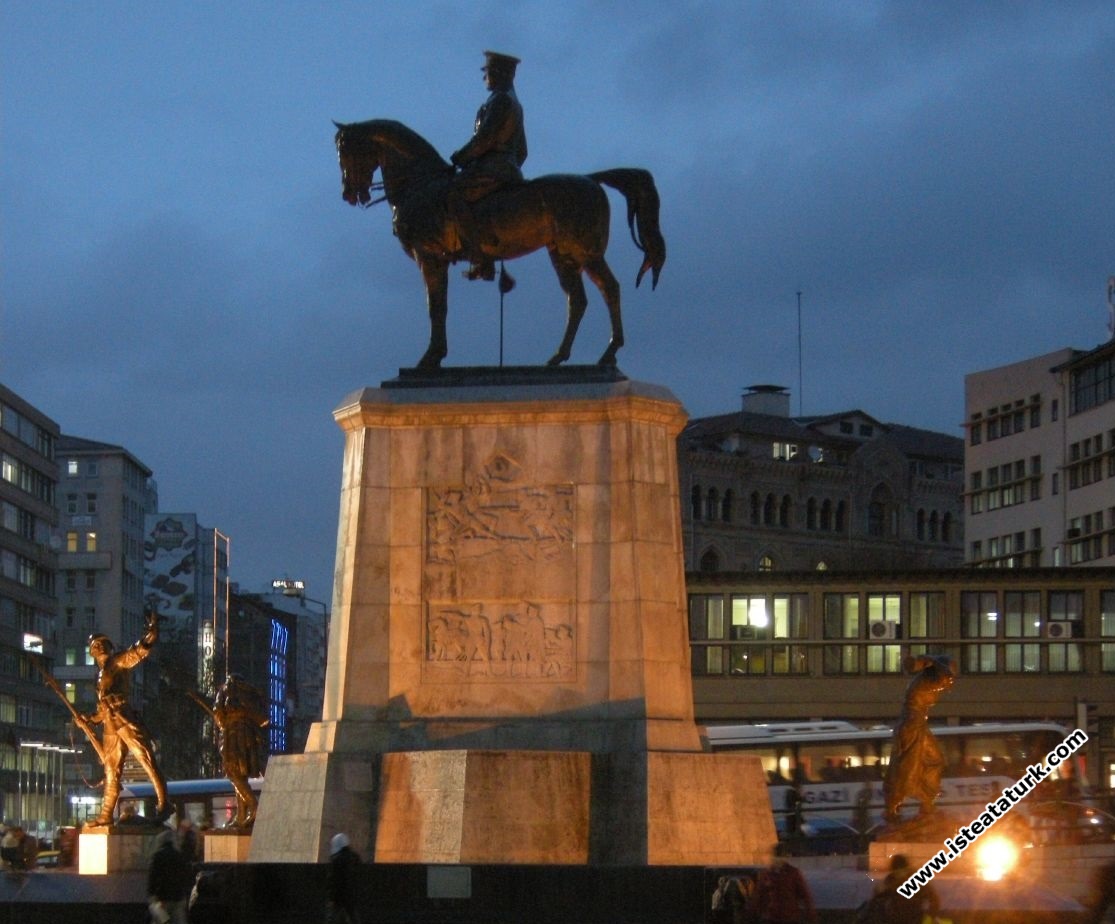
Victory (Utku) Monument, Afyon
Character Size
Victory (Utku) Monument, Afyon
Victory (Utku) Monument, Afyon
Victory (Utku) Monument, Afyon
LOCATION: Afyon Municipal Park
Date: March 4, 1936 (Esen 1936:5)
ARTIST: Heinrich KRİPPEL
BY: Governorship (Governorship)
HOW TO PROJECT :-
SELECTION COMMITTEE :-
COST: 59,446 TL. (Governorship)
PLACE OF PRODUCTION : Vienna/Vereinigte Metalwerke (Aslanapa 1993:46)
MONUMENT
Material: Sculpture; bronze, Pedestal; Stone (Andesite Coating)
Dimensions: Sculpture; 4.07 m., pedestal; h.2.5 m.
Inscriptions: On the back of the pedestal; Afyon City was occupied for the first time on 28 March 1921 and for the second time on 18 July 1921 by the Enemy Armies. It was liberated on August 27, 1922, and this monument was erected to the National Army and the Great National Hero Atatürk as a tribute to the people of Afyon.
Reliefs: There are bronze relief plates on all four sides of the pedestal.
Front facade: Atatürk Portrait.
Left flank: Atatürk and his comrades making an attack plan.
Background: War composition.
Right side front: Afyon people's thanksgiving to the army.
Registration Number: 03.00.0/1.0
HISTORY:Afyon Victory (Utku) Monument is located in the park opposite the Municipality building today. In other words, the monument is at the foot of the Afyon castle. The back face is towards the castle and the front face is towards the city. After the monument was erected at this point, a park arrangement was made to include the monument in accordance with the topography. The park has two levels (set). The part with the pedestal and the statue remains above. Here, a plain was created to allow the people to walk around the monument. The second part is lower than the first part. It consists of a pool on the axis where the pedestal is located, and stairs on both sides that provide access to the upper part. The place where the Afyon Victory Monument was erected has a historical significance. In the place where the municipality and governorship buildings are located today, the existing building at that time was used as a headquarters by Atatürk and his comrades. In this room, the Battle of Dumlupınar / Battle of the Commander-in-Chief, which took place in August 1922, was planned. The monument was erected at the location where your attack was planned for the purpose of liberating Afyon, the success of the Turkish military forces, and the transfer of the August 30 Victory to future generations. For this reason, the Pasha Mosque, which was present in the place where the monument is located, was demolished (registration). No document has been found regarding the way the gold was designed. The cost of the work, made by the Austrian sculptor H.Krippel, is 59,446 TL. It is known that the artist created all the monuments he applied in Turkey in his workshop in Vienna (Aslanapa 1993:46). Therefore,
The opening ceremony of the monument was held on March 24, 1936. Chief Deputy İsmet İnönü, Public Works, Finance, Economics Deputies, Party Secretary General Recep Peker and journalists arrived in Afyon by train at 10.30 for the opening ceremony of the Monument. Municipal and Governorate delegations, military platoon, band, scouts, students and the public participated. The President of the Community Center made the first speech in front of the flag-wrapped statue. After the governor's speech, Prime Minister İnönü cut the ribbon holding the flag and inaugurated the statue. The opening ceremony ended with İsmet İnönü's conversation (Esen 1936:5). At night, a feast for three hundred people was given by Afyon Community Center in the hall of the Community Center. At the feast, various pieces were performed by the Musical Branch of the Community Center (Anonymous 1935 y:119).
DEFINITION: The work consists of two parts, a pedestal and a sculpture. On the pedestal, there is a bronze figure group about four meters high. The figure group consisting of two male figures is depicted on a rock. One of the figures, both naked, is standing and the other is lying on the ground at his feet. The figure lying on the ground symbolizes the enemy, and the figure on the foot that is about to attack him symbolizes the Turkish nation (Governorship; Registration). There is an inscription under the foot of the figure symbolizing the Turk (on the reverse). The original phallus of this figure was found immoral and was cut off in the 1950s (Register).
%20An%C4%B1t%C4%B1%20Almanyada%20at%C3%B6lyede%20yap%C4%B1m%20a%C5%9Famas%C4%B1nda.jpg)
Victory (Utku) Monument under construction in workshop in Germany
.jpg)
%20An%C4%B1t%C4%B1%20(2).jpg)
There are relief depictions in profiled, square frames on the four sides of the two and a half meter high square sectioned plinth. According to Aslanapa (1993: 46), the subjects of the reliefs were given by Atatürk. On the first façade, Atatürk's portrait depicted in profile and the artist's signature can be seen in the lower right corner. 29/30 AG on the profile of the frame on the second facade. It is dated 1922. Atatürk, İnönü and Fevzi Çakmak are depicted sitting around a table. Figures are given in profile. Fevzi Çakmak put his fist on the map on the table. While Atatürk's one hand was on the map in the form of a fist, the other hand reached forward to express determination. İnönü also points to places on the map with one hand. Atatürk, İnönü and Çakmak on 28 August 1922 in Afyon. They entered the city and used the room where today's Municipality building is located as their headquarters. Here they made a plan to dismantle the enemy. The relief shows Atatürk and his comrades making the plan of attack on the map (Çetinkaya 1935:99). On the third front, on the profile of the frame 31 NET. The date 1922 is read. The battle scene depicts the enemy forces trying to hold on in Dumlupınar, being repelled with a final blow. On the fourth front, 27 NET on the profile of the frame. It is dated 1922. Turkish" soldiers carrying the flag and a male figure with a cap kissing the flag are depicted. According to Çetinkaya(1935:99), the people of Afyon and Afyon, who were under the captivity of the enemy armies, were rescued by our National Armies on August 27, 1922 and placed on our flag,
_%2022.jpg)
Atatürk's arrival in Afyon, his visit to the Utku (Victory) Monument. (November 20, 1937)
The statues on the pedestal are larger than normal human sizes and the movements are extremely lively. The agonizing facial expression on the head of the figure lying on the ground, symbolizing the invaders and hanging down in great helplessness, and the exhausted body indicate defeat. On the face of the standing figure, there is a great expression of anger. With his stretched muscles, swollen neck veins, upturned arms, one of his hands clenched into a fist, his hands outstretched as if to tear something apart, he looks down on the figure lying under his feet and almost crushes it.
During his visit to Afyon in 1937, Atatürk expressed his appreciation for the monument by saying "the monument that best describes the Great Victory" .
_%20.png)
Atatürk's arrival in Afyon, his visit to the Utku (Victory) Monument. (November 20, 1937)

Victory Monument in Turkey Posts
Sculptor Heinrich Krippel
He was born on September 27, 1883 in Vienna. He studied sculpture at the Academy of Fine Arts in Vienna, and previously worked on tombs and portraits. In Turkey, where he was invited by the Turkish Government between 1925 and 1938, Sarayburnu Atatürk Statue (1925), Konya Atatürk Statue (1926), Ankara Atatürk Statue (1927), Samsun Atatürk Monument (1931), Afyon Karahisar Victory Monument (1935). ), left works such as the Seated Atatürk Monument (1938) in Ankara Sümerbank.
Atatürk hosted the artist in the mansion for these works and posed for him for the monument. The sculptures of the monument group were designed in the artist's workshop in Vienna, cast in bronze at the Vienna United Mining Works, brought to Turkey in pieces and assembled on site. The artist died on April 5, 1945 after a stomach operation in Vienna.
Source: A A M Cumhuriyet Dönemi Anıt Heykelleri, Yrd. Doç. Dr. Kıvanç Osma, Ankara 2003. ISBN: 975-16-1678-6. Sayfa: 102-106
Victory Monument Images











